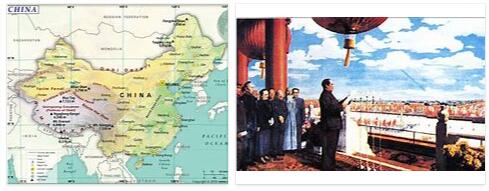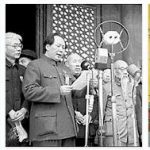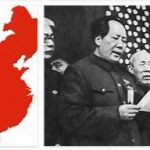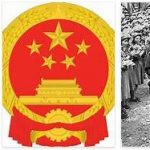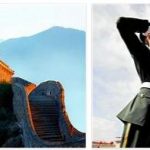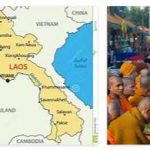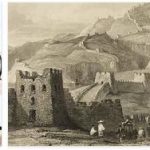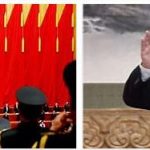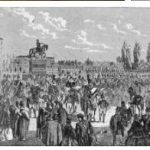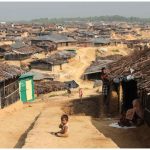The downside of the economic upswing was the previously unknown inflation, corruption and the increase in serious crime, which the government fought with mass executions. The restrictive measures of the reform course included the ban on wall newspapers (1979), the elimination of the right to strike from the constitution (1982) and the administratively decreed “one-child marriage” to curb the strong population growth. The party also took decisive action against “bourgeois-individualistic tendencies” in art and literature. It insisted on the primacy of Marxism-Leninism, the democratic dictatorship of the people, the socialist path and the leading role of the CCP in state and society (“Four Basic Principles”). Numerous demonstrations by students for more civil liberties around the turn of the year 1986/87 exposed the conflict between economic and technical opening and political isolation. In 1987, Hu Yaobang was forced to resign as general secretary of the CCP in favor of Zhao Ziyang; Li Peng (Li P’eng) became Prime Minister. In 1988, Yang Shangkun (Yang Shang-k’un) took over the post of head of state.
Under the auspices of Deng Xiaoping, the party and government continued policies of economic reform; a new corporate law (1988) expanded the powers of corporate governance at the expense of the power of party secretaries. On the occasion of the funeral ceremonies for the former Secretary General Hu Yaobang (mid-April 1989), who had also shown himself open to political reforms during his term in office, there were mass student demonstrations in Beijing for more freedom and democracy. The movement, which other sections of the population also joined, spread to other cities. On May 18, 1989, a demonstration with over 1 million participants took place on Tiananmen Square in Beijing. On the initiative of Deng Xiaoping, Li Peng and Yang Shangkun suppressed army units on March 3rd and 4th. 6. 1989 the protest movement in a bloody military action that left many dead (according to official Chinese figures from 1996 in Beijing 523, throughout China during the protests 931; earlier Western estimates were much higher). Zhao Ziyang, who opposed the military action, lost his position as general secretary of the CCP to Jiang Zemin (Chiang Tse-min). Up until 1991, numerous participants in the student reform movement were sentenced to long prison terms or to death.
In view of the collapse of the communist systems of rule in Europe, China firmly adhered to the basic principles of communist understanding of the state and society. After a period of domestic political restoration, Deng Xiaoping launched a campaign to continue economic reform in 1992. In 1993 the National People’s Congress elected party leader Jiang Zemin as president and replaced the term “planned economy” with “socialist market economy” in the constitution. With the appointment (March 1998) of the reform exponent Zhu Rongji (Chu Jung-chi) as prime minister, the state and party leadership underlined the urgency of economic reforms. In March 1999 the National People’s Congress added an amendment to the constitution recognizing private companies as an “important pillar” of the “socialist market economy”. However, China was also confronted with a severe economic crisis in the wake of the general economic depression in Asia (from 1997). The growing social problems, including rising unemployment, the large number of migrant workers and social differences in the big cities, created a considerable potential for unrest. The continued protection of the CCP’s monopoly of power in the 1990s was on the one hand the undiminished repressive action against opposition members and dissidents (i.a. Falun Gong) and, on the other hand, the fight against crime, economic crimes and corruption (right into the party ranks). Repeated unrest in Tibet since 1987 and Sinkiang since the 1990s exposed political tensions with national minorities.
In terms of foreign policy, the rapprochement with the West was maintained. In 1978, China, a country located in Asia according to estatelearning.com, signed a peace and friendship treaty with Japan. In 1984 negotiations with Great Britain on the future status of the Crown Colony of Hong Kong were concluded with an agreement after the lease period had expired in 1997; another agreement with Portugal (1987) stipulated the return of Macau to China in 1999. On July 1, 1997, Hong Kong was incorporated into the People’s Republic under special conditions (Special Administrative Region); On December 19, 1999 (with effect from December 20), Macau was also handed over, which also received the status of a special administrative region.
Relations with the USSR, on the other hand, remained tense for a long time in view of the Soviet support of Vietnam, with whom China waged a border war in 1979 over the Cambodian question (Cambodia), and the Soviet invasion of Afghanistan (late December 1979). In 1980, China terminated the 1950 friendship and assistance treaty and successfully tested the first ICBM in the same year. In the 1980s, contacts with the Eastern Bloc increased again. In May 1989, Deng Xiaoping and M. S. Gorbachev finished the decades-long ideological dispute between the Chinese and the Soviet Communist Party. However, the Chinese leadership was critical of the democratic turnaround in East Central Europe from autumn 1989. After the dissolution of the Soviet Union (1991), there was a further rapprochement with its successor state Russia: a military agreement was concluded in 1993 and a border agreement in 1994; In 1995 economic agreements were added.
